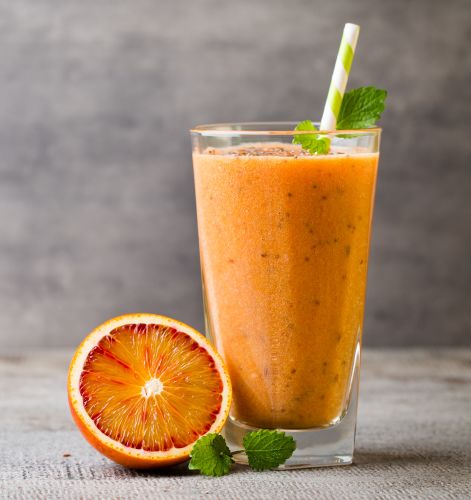Omega 3 oil sea buckthorn with DHA + EPA algae oil
48 g Omega-3 fatty acids per 100 g

- Lin oil with DHA and EPA from algae oil
- supports heart, eye and brain functions
- only one tablespoon per day = 250 mg DHA + 125 mg EPA
- especially for vegans, vegetarians and pregnant women
- rounded off with sea buckthorn pulp oil
- purely plant-based and resource-saving
from 2916 ratings





** The positive effect is achieved with a daily intake of 250 mg DHA.
 Our Omega 3 oil goes perfectly with breakfast muesli
Our Omega 3 oil goes perfectly with breakfast muesliWe recommend our high quality Omega-3 Linseed & Sea Buckthorn Oil with DHA and EPA for an optimal supply of Omega-3s. It is a combination of valuable algae oil and our freshly milled linseed and sea buckthorn oil. What makes this oil blend so special is its high levels of the essential omega-3 fatty acids alpha-linolenic acid, docosahexaenoic acid and eicosapentaenoic acid. You can get your daily requirement of ALA, DHA and EPA in just one tablespoon (8g) of the oil blend.
Positive for the heart, eyes and brain
ALA helps maintain normal blood cholesterol levels. Beneficial effects are achieved with 2 g of ALA* per day. DHA contributes to normal vision and brain function, and DHA and EPA contribute to normal heart function. Benefits are achieved with a daily intake of 250 mg of DHA and EPA.
DHA and EPA are important for meeting the increased demand for omega-3 fatty acids during pregnancy and lactation. To meet the increased requirement of 250 mg DHA and EPA + 200 mg DHA per day, a daily intake of approximately 10 g of omega-3 oil is recommended for pregnant and breastfeeding women.
*Eat a varied and balanced diet and maintain a healthy lifestyle. Keep out of the reach of children. Do not exceed recommended daily intake.
DHA and EPA - marine fatty acids
Docosahexaenoic acid (DHA) and eicosapentaenoic acid (EPA) are polyunsaturated fatty acids. The two marine fatty acids DHA and EPA are essential, as is the plant-based omega-3 fatty acid ALA. The body can make DHA and EPA from ALA, but only in very small amounts. They must therefore be obtained from the diet. This can be done through regular consumption of fish or suitable alternatives such as our DHA- and EPA-rich oils.
Algae oil - environmentally friendly and resource-saving
Cold-water fish are one of the main animal sources of omega-3 fatty acids. Sea fish take these fatty acids from algae, plankton and krill. Algae in turn produce DHA and EPA. DHA and EPA are also known as marine or aquatic omega-3s. To produce our omega-3 oils with DHA and EPA, algae are carefully cultivated under controlled conditions without the addition of harmful substances or antibiotics. Algae are more environmentally friendly because they are not taken from the sea, unlike endangered fish stocks. Our Omega-3 oils with DHA and EPA are particularly recommended for vegans, vegetarians, pregnant women and people with medical conditions.
Gentle production of algae oil by means of fermentation
Algae oil is produced by a fermentation process, unlike our cold-pressed edible oils. It is based on a special type of algae called Schizochytrium. This type of algae is known to produce natural omega-3 fatty acids, particularly DHA and EPA. The algae are cultivated in a process similar to the production of beer or yeast. This process takes place in a fermentation tank where the algae are provided with the sugars and other nutrients that they need in order to grow and produce the omega-3 fatty acids. The fermentation juice, which contains the omega-3 fatty acids DHA and EPA, is filtered once the algae have produced enough omega-3 fatty acids. The algae cells are then mechanically broken up to release the algae oil. The end product of this process is a pure vegetable algae oil rich in DHA and EPA.
Embedded in linseed oil and sea buckthorn oil
We embed the valuable algae oil in linseed oil and sea buckthorn pulp oil. Linseed oil is characterised by its high alpha-linolenic acid (ALA) content of around 50g per 100g. ALA is an essential fatty acid that is vital to the human body and can only be obtained from food. This makes our freshly milled linseed oil an ideal base for our DHA + EPA Omega-3 oil.
The oil blend is also enriched with sea buckthorn pulp oil to protect the quality of the oxidation-sensitive algae oil. The presence of natural vitamins A and E (carotenes, tocopherol and tocotrienol) provides optimum oxidation protection for the highly unsaturated fatty acids. The addition of sea buckthorn pulp oil also gives the oil blend a fruity note.
Why is our omega 3 oil with DHA and EPA healthy?
Omega-3 fatty acids are vital for our organism. The most important members of the omega-3 family include alpha-linolenic acid (ALA), docosahexaenoic acid (DHA) and eicosapentaenoic acid (EPA). ALA, DHA and EPA form the basic building blocks of our cell membranes. They are indispensable for the organism, as they are responsible as messenger substances for signal transmission and chemical communication in the cells and are therefore necessary for optimal communication between the nerve cells.
DHA, EPA and ALA
The European Food Safety Authority (EFSA) has already approved the following health claims for DHA, EPA and ALA in the Health Claims Regulation:
- ALA contributes to the maintenance of normal blood cholesterol levels. The positive effect is achieved with a daily intake of 2 g ALA*.
- DHA contributes to the maintenance of normal vision and brain function. The positive effect is achieved with a daily intake of 250 mg DHA.*
- EPA and DHA contribute to normal heart function. The positive effect is achieved with a daily intake of 250 mg EPA and DHA*.
- The intake of docosahexaenoic acid (DHA) by the mother contributes to normal eye development in the fetus and breastfed infant. The positive effect occurs when 200 mg DHA is taken daily in addition to the recommended daily dose of omega-3 fatty acids for adults (250 mg DHA and EPA)*.
- The intake of docosahexaenoic acid (DHA) by the mother contributes to normal brain development in the fetus and breastfed infant. The positive effect occurs when 200 mg DHA is taken daily in addition to the recommended daily dose of omega-3 fatty acids for adults (250 mg DHA and EPA)*.
(*As part of a varied and balanced diet and a healthy lifestyle).
ALA is essential
Because ALA is found only in plants and our bodies cannot produce this high-quality fatty acid, it must be obtained from food. For example, ALA is found in chia oil (63 g per 100 g), linseed oil (50 g per 100 g) and camelina oil (42 g per 100 g). The situation is similar for DHA and EPA. Our bodies are able to produce DHA and EPA from ALA with the help of enzymes, but only to a small extent, so the human body is dependent on an appropriate food source.
Recommended for vegan diets

For people on a vegetarian or vegan diet, DHA and EPA enriched flaxseed oil is particularly recommended. Our freshly milled flaxseed oil itself contains 50 g of the omega-3 fatty acid alpha-linolenic acid (ALA) per 100 g. Alpha-linolenic acid (ALA) enables our bodies to produce small amounts of DHA and EPA. The fatty acid ALA is found in other edible oils such as chia oil (63 g per 100 g) and camelina oil (42 g per 100 g). However, these sources alone are not always enough to provide the body with sufficient DHA and EPA.
It is recommended that you supplement your diet with cold-water fish or algae oil to avoid a deficit in long-chain fatty acids. If you choose not to eat fish, algae oil is a good choice. Algae oil is an ideal alternative to fish products, especially for vegetarians, vegans or people who do not eat fish or do not like the 'fishy burp' after taking fish oil capsules. Algae oil is also free of fish proteins, which can cause allergies in some people.
Usage
To ensure optimum absorption of the omega-3 fatty acids, we recommend taking the omega-3 oil with a main meal containing fat. Due to its heat sensitivity, the food supplement should only be used for cold preparation and not for frying.
Recommended intake: The positive effect is achieved with a daily intake of 250 mg EPA and DHA, which corresponds to 8 g of oil (1 tablespoon). The recommended daily intake must not be exceeded. Ensure a varied and balanced diet and a healthy lifestyle. Keep out of the reach of children.
Storage: Omega-3 fatty acids are very sensitive to oxidation. For this reason, Omega 3 Linseed & Sea Buckthorn Oil with DHA + EPA should be stored in the refrigerator. This is especially recommended after opening the bottle. The oil mixture can be kept there for around 14 weeks.

Recipe

Smoothie with rosehip powder
Recipe for a smoothie with blood orange, papaya and fresh mint. With rosehip powder from organic rosehips. zum Rezept
Turmeric ginger shot
Easy recipe for a ginger shot with turmeric powder. Rounded off with freshly squeezed orange and lemon juice, mill-fresh flaxseed oil and agave syrup. zum Rezept
Rocket salad with halloumi cheese
Quick and easy recipe for a salad with rocket and romaine lettuce and halloumi. Dressing with omega DHA oil and elderflower balsamic vinegar. Ideal as a starter or side dish. zum Rezeptweitere Rezepte
Ratings
Specification and ingredients
Food supplement with linseed oil with DHA (docosahexaenoic acid) and EPA (eicosapentaenoic acid) from the microalgae Schizochytrium sp.
Average energy and nutrient content for on portion (8 g)
Please enjoy our products as part of a diverse and balanced nutrition.
As a product of nature the composition of the oil can vary, the given specifications are therefore average values.





 Flaxseed oil
Flaxseed oil Black cumin seed oil
Black cumin seed oil Milk thistle oil
Milk thistle oil